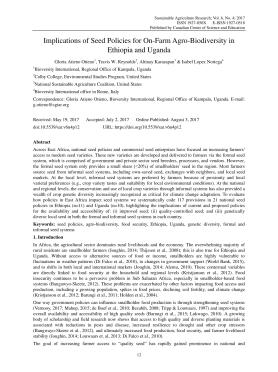Implications of Seed Policies for On-Farm Agro-Biodiversity in Ethiopia and Uganda
Implications of Seed Policies for On-Farm Agro-Biodiversity in Ethiopia and Uganda
In Africa, the agricultural sector dominates rural livelihoods and the economy. The overwhelming majority of rural residents are smallholder farmers (Joughin, 2014; Thijssen et al., 2008); this is also true for Ethiopia and Uganda. Without access to alternative sources of food or income, smallholders are highly vulnerable to fluctuations in weather patterns (Di Falco et al., 2010), to changes in government support (World Bank, 2015), and to shifts in both local and international markets (Joughin, 2014; Alemu, 2010). These contextual variables are directly linked to food security at the household and regional levels (Kristjanson et al., 2012). Food insecurity continues to be a pervasive problem in Sub Saharan Africa, especially in smallholder-based food systems (Bangawyo-Skeete, 2012). These problems are exacerbated by other factors impacting food access and production, including a growing population, spikes in food prices, declining soil fertility, and climate change (Kristjanson et al., 2012; Barungi et al., 2011; Holden et al., 2004).
One way government policies can influence smallholder food production is through strengthening seed systems (Vernooy, 2017; Mahop, 2015; de Boef et al., 2010; Bezabih, 2008; Tripp & Louwaars, 1997) and improving the overall availability and accessibility of high quality seeds (Barungi et al., 2015; Lukwago, 2010). A growing body of scholarship and field research now shows that access to high quality and diverse planting materials is associated with reductions in pests and disease, increased resilience to drought and other crop stressors (Bangwayo-Skeete et al., 2012), and ultimately increased food production, food security, and farmer livelihood stability (Joughin, 2014; Louwaars et. al, 2013; Di Falco et al., 2010).

